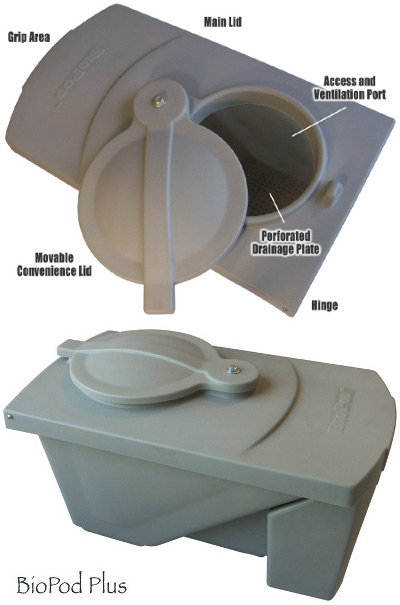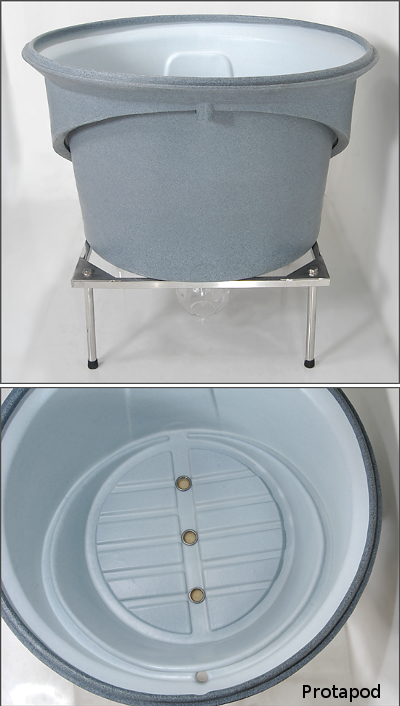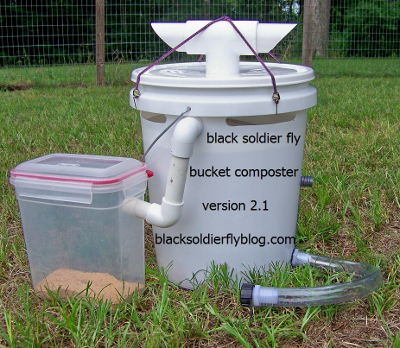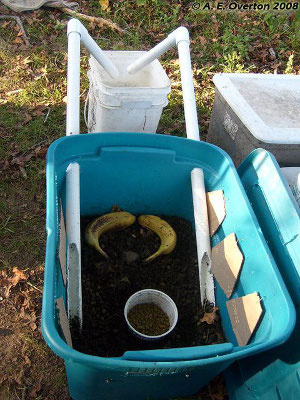
Homemade black soldier fly bins
 I've
dragged my feet about starting black soldier flies because the bins are
relatively complicated, but after a bit of internet research, building
our own is starting to feel feasible. It sounds like a successful
black
soldier fly bin will have good drainage at the bottom, air holes at the
top to let in adults wanting to lay their eggs, and a ramp for the
larvae to crawl up and out into the collection bucket.
I've
dragged my feet about starting black soldier flies because the bins are
relatively complicated, but after a bit of internet research, building
our own is starting to feel feasible. It sounds like a successful
black
soldier fly bin will have good drainage at the bottom, air holes at the
top to let in adults wanting to lay their eggs, and a ramp for the
larvae to crawl up and out into the collection bucket.
Raising black soldier
flies is a relatively new endeavor, and there only seems to be one
company producing pre-made bins. The original bin was called a
Biopod, but now there are two different types of commercial bins
available --- the Biopod Plus (which replaced the original Biopod) and
the larger Protapod.
If you were going to buy
one of these bins new, you'd be shelling out $180 for the Biopod Plus, which composts 5 pounds
of food waste per day, or $350 for the Protapod, which composts 20
 pounds of food waste per day. Both bins are way too expensive for
us, but they do serve as templates for the do-it-yourselfer. The
ramp seems to be the complicated part of the system, since it needs to
start at the bottom of the bin and lead up to the top at no more than a
40 degree angle. Most homemade bins I've seen have mimicked the
original Biopod (and Protapod), trying to make a ramp lining the inside
of a circular bin, but various websites report that it's tough to
attach the ramp to the inside of the bin since it's wet in there and
the larvae work hard to tear everything apart. Instead, the
rectangular bin of the Protapod Plus with the simpler ramp seems like a
system that could be replicated on the home scale with much more ease.
pounds of food waste per day. Both bins are way too expensive for
us, but they do serve as templates for the do-it-yourselfer. The
ramp seems to be the complicated part of the system, since it needs to
start at the bottom of the bin and lead up to the top at no more than a
40 degree angle. Most homemade bins I've seen have mimicked the
original Biopod (and Protapod), trying to make a ramp lining the inside
of a circular bin, but various websites report that it's tough to
attach the ramp to the inside of the bin since it's wet in there and
the larvae work hard to tear everything apart. Instead, the
rectangular bin of the Protapod Plus with the simpler ramp seems like a
system that could be replicated on the home scale with much more ease.
Black
Soldier Fly Blog's DIY five gallon bucket bin has been tried by several
folks and is reported to do quite well, although you have to manually
raise and lower the ramp. The site is a great place to start your
research into black soldier flies, but the bin is too small for most
people, handling only about a pound of food scraps per day.
 My favorite DIY bin so
far has been the
one pictured below,
which uses the same idea as the Biopod Plus to make a simple, mid-scale
bin out of a tupperware container and some PVC pipe. The PVC
method makes it seem like you could scale this version
up
indefinitely. You can see a
similar bin with more step by step instructions here. Some experts worry
that the larvae won't be able to find the ramps in this sytem, but
others report that they get very good crawl-off.
My favorite DIY bin so
far has been the
one pictured below,
which uses the same idea as the Biopod Plus to make a simple, mid-scale
bin out of a tupperware container and some PVC pipe. The PVC
method makes it seem like you could scale this version
up
indefinitely. You can see a
similar bin with more step by step instructions here. Some experts worry
that the larvae won't be able to find the ramps in this sytem, but
others report that they get very good crawl-off.
When
designing your bin, keep in mind that surface area determines how much
food waste your bin will compost per day. Every square foot of
 surface area will allow you to put in about 3 pounds of food waste, so
for the 18 pounds of food waste currently going begging from our food
scrap program every
day, we would need 6 square feet of bin. It
seems remarkable that such a small bin could handle so much waste, but
black soldier flies are insatiable.
surface area will allow you to put in about 3 pounds of food waste, so
for the 18 pounds of food waste currently going begging from our food
scrap program every
day, we would need 6 square feet of bin. It
seems remarkable that such a small bin could handle so much waste, but
black soldier flies are insatiable.
That said, black soldier
flies aren't out flying in cold weather and
their larvae can't work when temperatures are too cool, so this might
not be the short-term solution for our extra food scraps after
all. Stay tuned for more on the black soldier fly life cycle and
how to winterize bins in later posts.
| This post is part of our Black Soldier Fly lunchtime series.
Read all of the entries: |
Want more in-depth information? Browse through our books.
Or explore more posts by date or by subject.
About us: Anna Hess and Mark Hamilton spent over a decade living self-sufficiently in the mountains of Virginia before moving north to start over from scratch in the foothills of Ohio. They've experimented with permaculture, no-till gardening, trailersteading, home-based microbusinesses and much more, writing about their adventures in both blogs and books.
Want to be notified when new comments are posted on this page? Click on the RSS button after you add a comment to subscribe to the comment feed, or simply check the box beside "email replies to me" while writing your comment.

Jorge --- Sounds like a fascinating system to try out! We ended up discovering we have plenty of wild black soldier flies, so didn't need to find commercial sources. I might be leery of introducing them to Puerto Rico if they don't already exist there --- invasives can have unintended consequences....
I wish we could visit you in Puerto Rico! It's tough to drag me off the farm even to visit my mother an hour away, though.